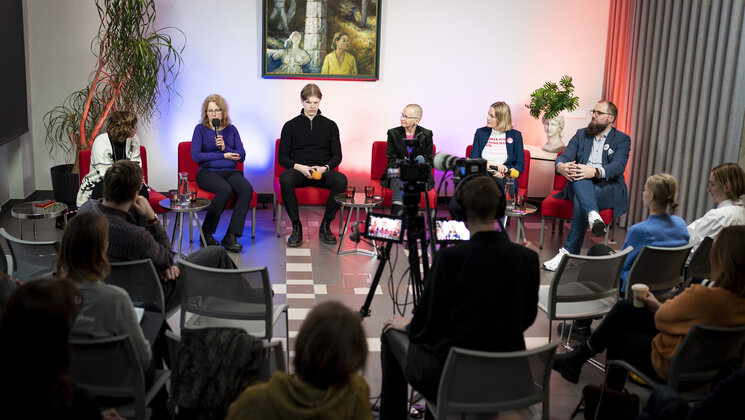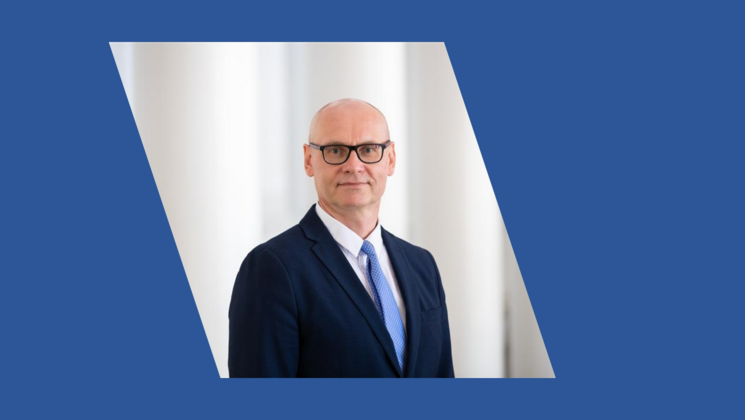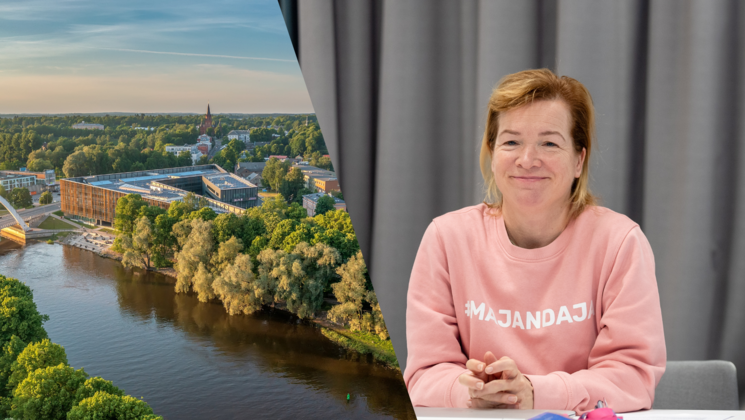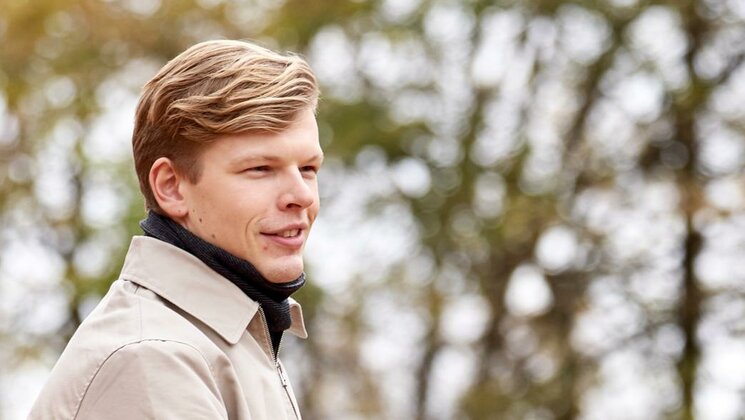Universitas Tartuensis visited the rector in his summer house

Universitas Tartuensis paid a visit to Rector Toomas Asser, now in his second term of office, at his summer house to ask him about his thoughts ahead of his new term in a more relaxed atmosphere. It should be noted that the meeting took place just before the summer holidays of July and the heated discussions on research ethics and data protection of August.
The large windows of the country house in the rolling landscape of Kääriku look down on a raised pond. Daisies, catsfeet and other nostalgic meadow plants are blooming on an unmowed strip of land on the hillside. The light pink heath spotted orchid, a protected species, grows on the banks of the narrow stream.
Like the garden, the house is spacious. “It was designed so that also our children would fit in. My three children and six grandchildren often come here,” said Asser, nodding towards an early-teen boy absorbed in his smartphone in the corner of the sofa. “The youngest grandchild is five months old.”
In the background, we can see the Vanapoisimägi hill – a neighbour has cleared the forest from the slopes, and just a few trees are standing on the bare hill. “That’s spruce bark beetle damage,” Asser explains.
Rector’s wife Karin (also a doctor – a radiologist at the university hospital) brings a coffee pot, a napoleon cake and strawberries to the table, and leaves.
Half-way line: five done and five to go
Asser has held the rector’s position for five years, and the next five are ahead. What did the rector feel when he was facing the fact that he would be leading this diverse, vibrant and complex organisation in a rather volatile environment for five more years?
“First of all, there was a sense of pride and gratitude for the support I received. A huge responsibility, of course,” says Asser. “If you think back, five years ago I didn’t have a deeper understanding of how things worked. The building of a team surely cannot be measured in weeks, probably not even in a few months. But I do not doubt that the new team will be just as good. Two-thirds of the previous members of the Rector’s Office will continue.”
What does the rector value the most in his teammates?
“Commitment. The most pleasant experience from the past five years was working with highly dedicated and smart people,” he says. “And it has been real commitment. Kristjan Vassil, who is now leaving [his job as vice rector for research], always thought along and was a proactive member of the Rector’s Office; or, for example, Aune Valk, whose analytical capacity I have always stressed...”
The rector’s job is mainly about communicating: with colleagues both inside and outside the university, as well as internationally. The rector’s task is to maintain open communication with the political circles, the government and the press. But what about students?
“The contact with students goes more through the student union,” the rector admits. “Of course, there is contact with students, but it is no longer at the level of a lecturer and student, but more of an administrator and student.”
Taking the bull by the horns: how does the university intend to address the students’ major concern – the shortage of dormitories, which was also discussed during the election debates?
The rector nods. “Student housing is indeed an acute concern, and it affects the real estate market of the whole university town,” he admits. “Private entrepreneurs should also see the potential for building student dormitories of affordable rents because the university’s possibilities to respond are narrower than in the private market. We currently have a plan to renovate one dormitory a year. This, however, means that the respective number of places will be out of use every year. We’ll soon start preparing a new capital budget, and I won’t rule out looking for possibilities to expand the Raatuse dormitory. We have the land and the building rights; it’s just the question of funding.”
And is there any hope for a budget-friendly student canteen?
“We will continue to look for solutions together with students and entrepreneurs, and we haven’t lost hope after the pilot project in spring,” the rector assures.
In a large organisation like the university, practical issues are only a fraction of what the Rector’s Office has to deal with. Which part of the rector’s job seems the most difficult?
“I don’t really like the word difficult, or the word challenging,” Asser reflects. “Life is varied, offering opportunities and duties that are not necessarily difficulties. Much attention goes to keeping interpersonal relationships. It is common, after all, to have different perceptions and expectations even with our closest people; we are different as persons and react in different ways. The tenser the situation, the more emotions emerge. It needs balancing, and that is probably the leader’s role: to listen and give opportunities to act.”
The rector notes that his previous positions (as a neurosurgeon, professor, head of the Neurology Clinic, and dean of the Faculty of Medicine) have taught him to cope with stress reasonably well.
Species-rich garden
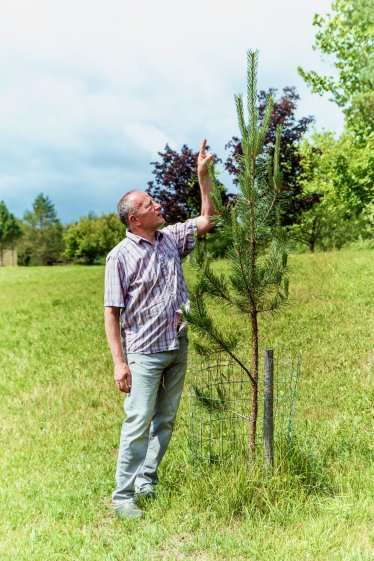
For a photoshoot for the magazine, photographer Lauri asks the rector to show us the scenery surrounding the house. Nearly 300 trees of different species have been planted here, including the clone of the world’s tallest (46.6 m) pine tree, the Ootsipalu pine, a gift from colleagues. The rector planted its clone sister in the Botanical Garden on the occasion of the 100th anniversary of Estonia’s national university.
“Karin plans the gardening works, and I am happy to help make it happen,” Asser says jokingly, pointing out the Canadian maple that is particularly eye-catching in autumn colours.
It was pouring rain on our way to Kääriku. Now the sun showed itself just long enough for the photographer to capture a good shot of the rector. And then it clouded over and is drizzling again.
“Can I ask you something, too?” asks Lauri, with a twinkle in his eye, packing up his cameras.
“We discussed with colleagues in the studio that the cameraman’s collapse during the live TV broadcast of the rector candidates’ debate looked as if it had been staged.” Lauri hints at how Toomas Asser rushed to help the cameraman in the middle of the debate, causing a short pause in the programme.
The rector smiles. “I have heard this talk, yes. I waited for a moment, and no one moved. As a doctor, I could not act otherwise.”
The rain is still not picking up, just a gentle drizzle. We take our coffee cups and go out to the patio.
Choices facing the university
During the conversation with the rector, you cannot get around the burning issues that have set alarm bells ringing for years.
For example, this February, more than 3,000 researchers from four universities issued a joint petition, expressing their urgent concern about the deepening crisis in education. The lack of doctoral students and future teaching staff is threatening both higher education and democracy in Estonia. Also Universities Estonia, which Toomas Asser chairs, has issued a declaration. Is there anything the universities can do about it?
“At the moment, we do not have a good answer – either the students start to pay for their studies or the government gives the money,” the rector says. “The attractiveness of academic jobs will depend on higher education funding. It is up to society to decide how much education, and of what quality, we need.”
What can Universities Estonia do to influence what is happening in education?
“Universities Estonia does not have many tools other than explaining and argumentation,” Asser says. “We need to convince politicians and society of the need for education. Given the quality and the level of education that we have, above all, at the University of Tartu – which is also internationally recognised – we have the reason to provide education. But I know there are other views – that there should not be so many educated people. This is something that needs to be argued out; there is no other way.”
Rector Asser gets visibly enthusiastic when talking about education. “The nature of work has changed so much that you cannot do without IT skills in almost any specialisation,” he says. “You need leadership skills and many other skills; they all should be part of your education. The world is getting more and more complicated. I don’t see any other solution for our country to survive than education.”
Now, the generation of the 2000s, young people born during the demographic low tide, has come to universities. Consequently, there are fewer people who can become university lecturers teaching in Estonian. In many academic buildings, you notice foreign-sounding names on the doors of doctoral students’ and researchers’ offices. Some researchers ask: if we don’t have Estonian students and doctoral students, shouldn’t we reduce the number of specialisations or admissions altogether?
“Indeed, the number of Estonians coming to higher education institutions has fallen significantly over the past 20 years,” says Rector Asser. “Academic succession, however, depends on the availability of doctoral students. The university’s requirements are quite high; all the teaching staff must hold a doctoral degree.”
In Estonia, a total of 300 doctoral student places are funded. Last year’s actual intake was 362.
“Yes, and the government expects as many to graduate each year,” the rector explains. “However, this obviously does not work like that – there are, in fact, only a little over two hundred graduates. In recent years, the percentage of those graduating within the standard study period has increased, and dropouts have decreased, but that is not enough. Universities also expect an increase in the number of publicly funded posts of junior research fellows. In relative terms, compared to most Western European countries, we are lacking about 150 doctoral graduates every year, so instead of 300, we should have around 500 entrants to doctoral studies.”
According to Asser, students take a pause in studies largely due to economic circumstances. “Until there is no progression straight from the bachelor’s level to the master’s and from there, for the most motivated, on to doctoral studies, the situation will not change.”
At the same time, we have a national target to increase the percentage of higher-educated people.
“In the national strategy “Estonia 2035”, the target for the share of higher-educated people in the 24–35 age group is 45%. (It is currently 43%, slightly below the OECD average of 46% – ed.) We are moving in this direction,” says the rector. “At the same time, we have a shortage of teachers across the country, especially physics and mathematics teachers. The number of applicants to teacher education programmes is known to be higher both in Tartu and at Tallinn University, and also the volume of state-commissioned education has grown. One of the University of Tartu’s long-term goals is to provide high-quality education to more people aspiring to become teachers. As a new measure, we and Tallinn University are launching the teachers’ academy – it will attract more learners, and hopefully, we can solve the problem with mathematics. The poor results in the mathematics exams in upper and lower secondary schools showed that there should probably be more compulsion to study mathematics at comprehensive schools. Currently, the attitudes have perhaps become too liberal.”
The situation with doctors is similar. The shortage of family doctors has been discussed for a long time, and now they say that soon, not everyone will have a family doctor. What could the university do?
“The volume of medical education needs to increase,” the rector is convinced. “There is no other option, because well over a quarter of the Estonian doctors have now reached retirement age. Depending on the specialisation, medical studies, including residency, take 10–11 years. The volume of medical education was incomparably higher in the 1980s, and their generation is now reaching retirement age. What can the university do? The Faculty of Medicine must plan its activities so as to be able to admit more students. It is up to the Rector’s Office to get the necessary funding from the government; we need to explain why it is necessary. This is absolutely inevitable. Family doctors have perhaps been the most talked about. Still, the problems are the same for other specialisations: emergency medicine, intensive care, pathology, and several narrower specialisations, where the number of medical students should be much bigger. We cannot raise the training amounts drastically because we do not have enough teaching staff right now, and we do not have the conditions in hospitals for students to practice. So, this needs to be addressed consistently in the coming years. Also, more collaboration is needed between hospitals.”
There is also talk about moving the Faculty of Medicine to Tallinn altogether. Because “Tallinn is where people are, and the hospital should be where the people are”.
The rector is concrete in his reply: “Medicine is not just the hospital; it is also the basic knowledge, and these cannot be separated. Medical education is and will remain in Tartu. Also residency is in Tartu. I agree, however, that the aspects that concern the patients, and their involvement in the study process, could be organised in hospitals all over Estonia. Understandably, this is not easy.”
Estonia’s national university or international university?
Our conversation moves on to the Estonian-language university. What is the rector’s view of the university’s role? Can we say that the national university is the stronghold of the Estonian language?

“This role is absolutely crucial, important for the preservation of the language and the cultural heritage,” the rector affirms. “But the roles of the national university and the international university do not need to be contrasted. The University of Tartu has a legal obligation to preserve the Estonian language, develop terminology, study our heritage, including our genetic code and carry out archaeological research. None of this could be done, however, without some international understanding of modern research methods and technologies.”
“If we want to show what we do to the world, we must communicate adequately with the external world, including the scientific community. For researchers to communicate with each other, we need to be in the same conceptual and quality space. The Estonian national topics are an object of research, yet even these cannot be studied without the expertise of an international network.”
Another good news is that from this autumn, a certain amount of Estonian language study is made compulsory for international students, doctoral students and teaching staff, and credits are awarded for that.
“Yes, it is not only language learning but also learning about the cultural life more generally,” says Asser. “Hopefully, this will connect international doctoral students and researchers even more closely to Estonia and create opportunities to continue working here. A lot depends on the managers’ motivation – they need to allow their international staff to participate in language learning.”
Toomas Asser is actively involved in several international networks of research universities. As a rector of the University of Tartu, he is a member of the board of The Guild, a member of LERU CE7 (the League of European Research Universities and seven Central European universities), and a member of the ENLIGHT steering committee.
What do rectors talk about at their meetings? What are they concerned about in the modern world?
“The problems are relatively similar to ours,” the rector says. “We recently discussed the survival of our languages with Elmer Sterken, a member of our university council, professor of monetary economics and former rector of the University of Groningen. The Netherlands is similarly concerned with preserving the Flemish language, even though their country is larger.”
According to Asser, university leaders are concerned about the situation in research more generally. “The Guild and LERU are lobby organisations, and their views are taken very seriously by the European Commission. It is a great value to be an equal member of these organisations – and I assure you that the views of the University of Tartu are valued there. I have been re-elected to the board of The Guild for three more years – a recognition by the European rectors. At the end of June, we came with [the head of the Rector’s Strategy Office] Taivo Raud from Brussels from the joint meeting of LERU and The Guild, where Europe’s next research funding programme was discussed: the priorities and directions to take. We have to defend ourselves there, too.”
The rector explains that the ENLIGHT network is focused on learning. “This is certainly one of the future trends in the European Higher Education Area: how the universities can share the learning environment, coordinate activities, and mutually recognise diplomas. The European university network sees student mobility as very important – it should not be taken as if the aim was to sell Estonia off; young people also need international experience. European university networks have also emerged because there is mutual trust and knowledge of other universities.”
In our conversation, we cannot ignore the war in Ukraine. When Russia attacked Ukraine, the University of Tartu responded with exemplary speed. The same morning, Asser called the meeting of the Rector’s Office to discuss the situation. The university has supported students and staff of Ukrainian origin as much as possible. How does the rector see the situation now?
“On the human level, it is a tragedy,” Asser admits. “We have 205 students of Ukrainian origin and about one hundred Ukrainian researchers and staff members. We cannot see inside these people, but we can all imagine that this psychological trauma will remain with the people for several generations. We try to be understanding, but it is clear that public aid is decreasing. On the other hand, we obviously have to understand that the Ukrainian people need to get on with their lives despite everything. We are trying to offer them language learning opportunities and scholarships. It is not as much as they would probably need, but it is some relief.”
“At the same LERU and The Guild meeting, we encountered some controversy over the war in Ukraine: was it right for the University of Tartu to be so rigid and no longer accept Russian and Belarusian students? I can confirm that the attitudes are not uniform in the European Higher Education Area either. There was a strong confrontation with LERU leaders – with whom we have otherwise excellent relations. We were very strongly supported by Sorbonne and many other universities, but not all. You just have to be determined here.”
For some reason, this reminds me of a colleague’s observation: at the Rector’s Office meetings, Asser listens to everyone’s opinions and then sums up tactfully, politely, concisely, but in such a way that no one is left in any doubt as to what the rector’s position is.
---
It may sound like a cliché, but it is true – by the end of our conversation, the clouds have parted, and the sun has made the world bright again. Temporarily, of course. The summer and autumn are still ahead. Everything goes on.
30 June 2023 in Kääriku
The country home, family time and travelling help relax
How does the rector switch off from work?
“I relax with my family. Here in this place. We do running, walking, a bit of cycling and skiing,” says Asser, adding with a smile, “But everything in moderation.”
Colleagues know about Toomas Asser’s interest in Japan – after training at the Institute of Brain Diseases of Tohoku University in Japan in 1988–1989, he has maintained professional ties with Japan. “After my return, we travelled with Professor Akira Takahashi to Kiev together, where an innovative method of treating cerebral artery aneurysms was developed at that time. My good colleagues and friends, Professor Nobukazu Nakasato, a pioneer of magnetoencephalography from Tohoku University, and neurosurgeons Professors Akira Ogawa and Hidetoshi Ikeda, world-class colleagues from Iwate University and Tokyo, have also been to the country house here.”
Rector Toomas Asser has also hosted the former ambassador of Japan, Hajime Kitaoka, and the current ambassador, Yukihiko Matsumura, on several occasions. I have shown them the rich scenery of South Estonia,” he says modestly.
Passion for travel and photography has taken the rector and his wife to many other exciting places besides Japan. “I often take pictures just with my phone, but I also have decent photography equipment. On the last longer trip to Wrangel Island, I took many photos. The island is beyond the Arctic Circle, the ice, the polar bears, and all the life there... One trip to Congo and Rwanda was very memorable. Once, we climbed three and a half kilometres up a mountain to see a live volcano at night.”
University activities in the new academic year
Rector Toomas Asser: “We have agreed on two important lines of action: sustainability and improving the university’s position compared to other universities. The place in the rankings is not an end in itself, but our course must be one of progress and improvement.
An understanding of sustainability starts from the mindset; it cannot be done by command. Sustainable thinking needs to be integrated into curricula in a way that is acceptable. University researchers are working on sustainable technologies that need to be brought into society. The university is also directly involved in the implementation of the Just Transition Fund in Ida-Viru county.
The new members of the Rector’s Office and their areas of activity are in place. A new strategic plan needs to be drawn up – the current one ends in 2025. We have discussed with the council that the strategic plan could have a longer perspective than five years. The new vice rector for development will coordinate the fields of sustainable development and entrepreneurship, which is also an important direction – it concerns the work of the Centre for Entrepreneurship and Innovation and the Grant Office.
As new members, Vice Rector for Development, Professor of Human Genomics Tõnu Esko and Vice Rector for Research, Professor in Community Ecology Mari Moora joined the Rector’s Office of Toomas Asser. Vice Rector for Academic Affairs Aune Valk, Director of Administration Kstina Noormets, Academic Secretary Tõnis Karki, and Head of Finance Kalle Hein will continue from the previous team. In addition, the deans of the faculties are members of the Rector’s Office. Former Director of Development Taivo Raud, member of the previous team, will continue as the head of the Rector’s Strategy Office.
The article was originally published in the magazine Universitas Tartuensis


